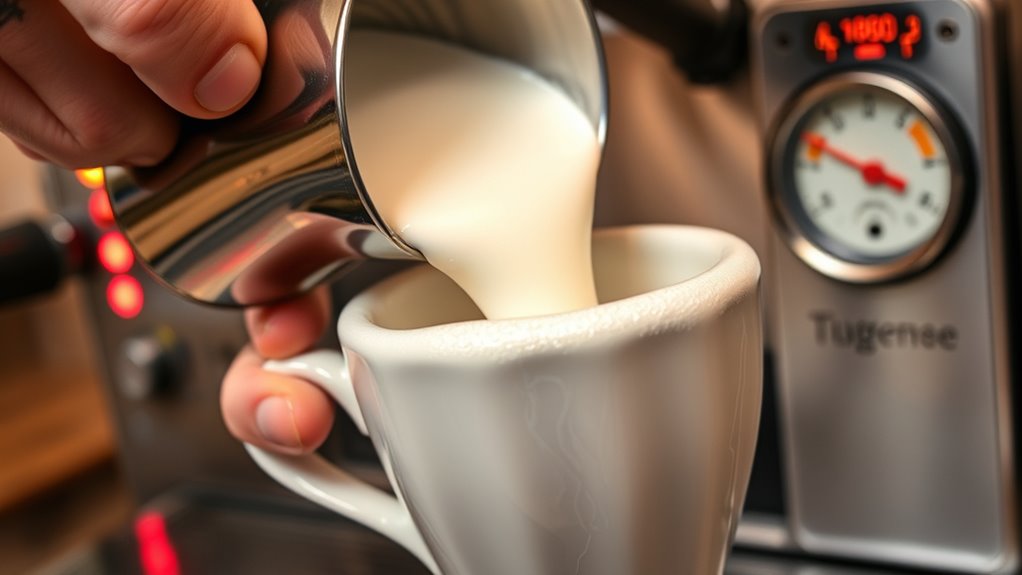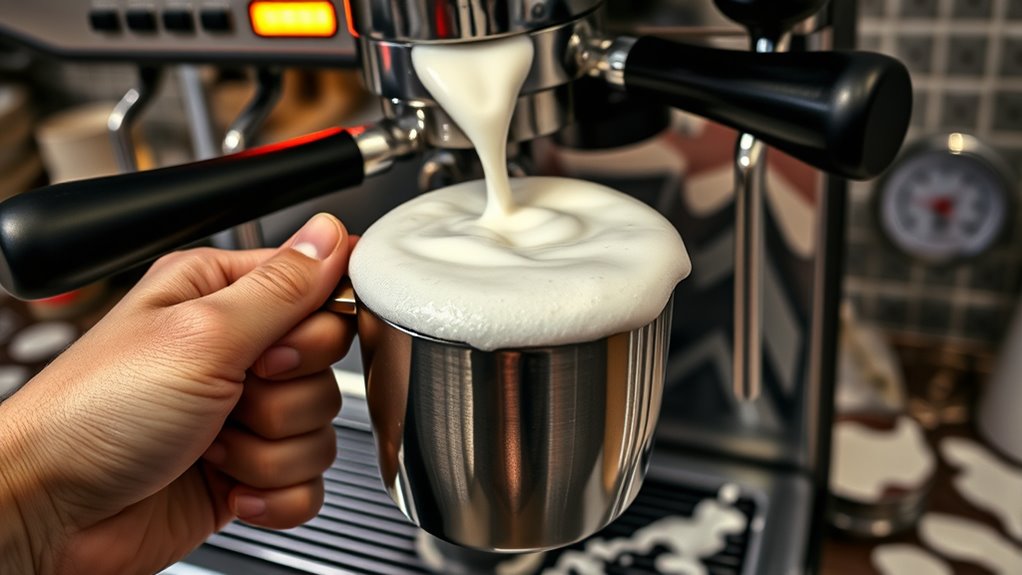To fix thin foam, make sure you’re using fresh, cold milk and position the steam wand just below the surface, introducing air gradually for microfoam. Avoid overheating by monitoring the temperature, aiming for 140-150°F, and stop steaming before milk gets too hot. If your foam splits or bubbles large, start with cold milk and steam gently. For more tips on perfect cappuccinos, keep exploring these techniques to perfect your craft.
Key Takeaways
- Use fresh, cold milk and introduce air early for velvety, dense foam, avoiding large bubbles.
- Keep the milk pitcher at an angle and position the steam wand just below the surface for microfoam.
- Monitor milk temperature carefully, stopping at 140-150°F to prevent overheating and splitting.
- Ensure proper grind size and tamping during espresso extraction to support foam stability and flavor.
- Practice gradual heating and gentle steaming to produce microfoam and prevent milk from splitting or burning.

If your cappuccino isn’t turning out quite right, troubleshooting can often pinpoint the issue and help you achieve that perfect frothy top and rich flavor. One common problem is thin foam, which usually results from improper milk frothing. To get that velvety, dense foam, make sure your milk is fresh and cold. Use a steam wand or frother to introduce air into the milk early in the process, but avoid over-aerating, which creates large bubbles instead of a smooth microfoam. Position the wand just below the surface of the milk, and keep the pitcher at an angle to promote even steaming. As you heat the milk, move the pitcher slightly to continue incorporating air, then submerge the wand deeper to heat the milk evenly without creating large bubbles. The key is to aim for a temperature around 140-150°F; overheating can cause the foam to turn thin or prevent it from forming altogether. Additionally, proper milk quality is essential for achieving the best froth texture and stability. Another frequent issue is espresso extraction, which directly impacts the flavor and crema of your cappuccino. If your espresso is under-extracted, it might taste sour or weak, and the crema may be thin or absent. To troubleshoot this, check your grind size—if it’s too coarse, water flows too quickly through the coffee, resulting in under-extraction. If it’s too fine, water struggles to pass through, causing over-extraction and bitterness. Adjust your grind accordingly. Also, ensure your tamping pressure is consistent; uneven tamping can cause channeling, where water bypasses the coffee and leads to weak extraction. The machine’s temperature and pressure settings are critical too. Make sure your espresso machine is properly heated and maintaining the right pressure, typically around 9 bars. Proper espresso extraction sets a solid foundation for your cappuccino’s flavor and the foam’s stability. Overheating milk can cause splitting or a burnt taste, ruining your cappuccino’s texture and flavor. If you notice the milk has a scorched smell or the foam collapses quickly, it’s likely too hot. To prevent this, monitor the temperature carefully during steaming. Use a thermometer if necessary, and stop steaming once you reach the ideal temperature range. Also, avoid rushing the process; gradual heating produces better microfoam and prevents the milk from overheating. If your milk splits or forms large bubbles, it often means it was overheated or steamed too aggressively. To fix this, start with cold milk, use a gentle steaming technique, and keep a close eye on the temperature. Consistently practicing your steaming technique and understanding your machine’s capabilities will help you maintain control over the heat and produce a smooth, creamy froth.
Frequently Asked Questions
How Can I Prevent My Milk From Splitting During Steaming?
To prevent your milk from splitting during steaming, focus on proper milk steaming techniques. Use fresh milk with a good shelf life, as older milk is more prone to splitting. Keep the steam wand just below the surface to create smooth, velvety microfoam, and avoid overheating the milk—aim for around 140°F (60°C). Consistently monitoring temperature and technique helps you achieve perfect, split-free milk every time.
What’s the Ideal Temperature for a Perfect Cappuccino?
The ideal temperature for a perfect cappuccino is around 150°F to 155°F, which you should aim for during milk frothing. Use your machine’s temperature control to maintain this range, ensuring the milk is hot enough to create rich foam without scorching. When you reach this temperature, turn off the steam to prevent overheating, helping you achieve smooth, creamy milk that complements your espresso perfectly.
Why Does My Espresso Taste Bitter or Burnt?
Your espresso tastes bitter or burnt because the roast level is too dark, which releases more bitter compounds. Additionally, over-extraction can cause flavor bitterness, so make certain you’re not brewing too long or using too fine a grind. Adjust your brewing time and grind size, and opt for a medium roast if you prefer a smoother, less bitter flavor. This will help you enjoy a richer, more balanced espresso.
How Do I Descale My Espresso Machine Effectively?
To descale your espresso machine effectively, start by choosing a descaling solution suited for your water hardness, as hard water requires more frequent descaling. For example, if you notice mineral buildup, run the solution through the machine following the manufacturer’s instructions. Typically, descaling every 1-3 months prevents issues. Always rinse thoroughly afterward to guarantee no residue affects your coffee’s flavor, maintaining ideal performance.
Can Different Milk Types Affect Foam Quality?
Yes, different milk types affect foam quality because milk composition and fat content vary. Whole milk, with higher fat, creates creamier, thicker foam, while skim milk produces lighter, more stable foam. Plant-based milks like almond or soy also differ in foaming ability due to their unique compositions. Experimenting with these options helps you find the best milk for your preferred foam texture and consistency, enhancing your cappuccino experience.
Conclusion
Now that you know how to troubleshoot common cappuccino issues, think of it like tending a delicate garden—patience and attention make all the difference. I once watched a barista fix thin foam by adjusting the steam wand, and suddenly, the cup transformed into a glossy masterpiece. Remember, each tweak brings you closer to that perfect sip. With a little practice, you’ll master your espresso garden and enjoy flawless cappuccinos every time.









